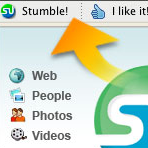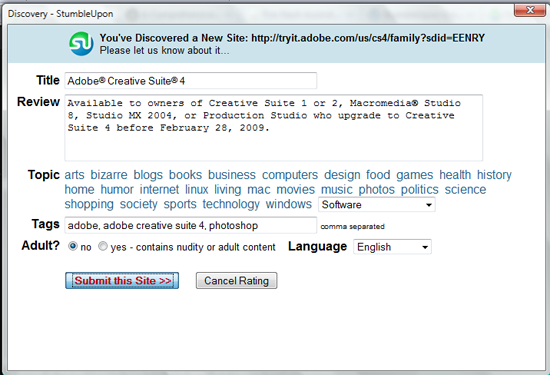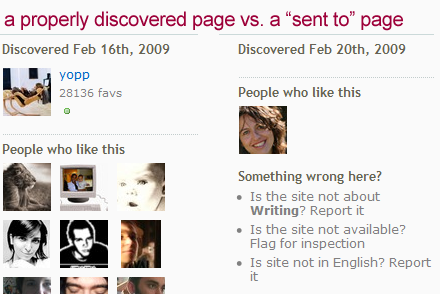Today I begin a series of articles that will teach you how to use StumbleUpon efficiently to maximize traffic to your site, and to all the sites you discover. I assume some of our readers are already StumbleUpon members, and for those who are not SU already has a page that helps as well – getting started.
The topic of today’s article is: Things that Kill SU Traffic
 StumbleUpon is a browser based social media community. I use “browser-based” in the absence of a better term. Although SU has a site where interaction between members is possible, the StumbleUpon Toolbar is the lifeblood of the network – it helps you browse the SU bookmarks, search, send messages to your SU friends, vote for web pages and much more. The toolbar is available for IE, Flock and Firefox – other browsers are not currently available.
StumbleUpon is a browser based social media community. I use “browser-based” in the absence of a better term. Although SU has a site where interaction between members is possible, the StumbleUpon Toolbar is the lifeblood of the network – it helps you browse the SU bookmarks, search, send messages to your SU friends, vote for web pages and much more. The toolbar is available for IE, Flock and Firefox – other browsers are not currently available.
The most important thing you need to learn in order “not” to “kill” potential SU traffic is how to use the toolbar correctly.
![]()
To better understand the terms below, here is a small glossary:
- To vote/stumble: to click on the “thumbs up” or “thumbs down” buttons to vote for a story; to click on the “stumble” button to browse the StumbleUpon database
- To discover: when you click “thumbs up” (and a page does not exist in the SU database) a pop-up appears telling you that you’ve discovered a new page. A discovery is not complete without a review, proper categorizing and tagging.
- To review: to write your personal comments about the page you vote for, or against; or to copy/paste a fragment of the content of the page
- To send to: to share a webpage with your friends, via SU toolbar or email
Sounds easy? Well, things get tricky if you don’t know the following rules:
First Discover, Then Review and Then Submit
For maximum traffic potential a page needs to be “discovered” from the browser toolbar and reviewed. To “discover” a page you click on the “thumbs up” icon. A pop-up will then appear asking you to review your discovery, to select the appropriate category for it, to tag it, to specify whether it contains adult content and only then to submit it.

This is the first review, and it is critical for the traffic volume a page might get. The new discovery will only enter the StumbleUpon queue of pages shown to the SU community if it has a review. Not reviewing condemns the page you discover to a slow death, especially if no other stumblers after you bother to write a review. Chances are , if you don’t write a review, no other stumbler will ever see that page.

Having these “dead” discoveries is also bad for your “Stumble karma.” The main interest of SU is to have active members. Simply clicking “thumbs up” and “thumbs down” does not make you an active member. The most popular stumblers have an impressive number of stumbles (votes), an impressive number of reviews, and also many subscribers (how to get subscribers in a future article). While it is not crucial to write a review each time you “stumble”, it is very important to write one when you “discover” a page obviously.
Pages that eventually receive reviews are “rescued”, but their chances of getting good traffic remain very low.
Don’t “Send to” New Pages without Discovering Them First
The easiest way to “kill” traffic chances for a page is to use the “send to” button in the StumbleUpon toolbar before discovering a page, and even before thumbing it up. SU allows its users to share (“send to”) pages regardless of their votes for the page. Sharing is a great thing, but not when you do it to the detriment of the page you want to share.
The page you “sent to” without reviewing enters the StumbleUpon database, but not the queue that will ensure that other SU users will see it.

Don’t Add StumbleUpon Buttons to Your Site
 Social sharing buttons and widgets are great: they help your visitors to submit your stories fast to the social and bookmarking sites of their choice. But did you know that onsite SU buttons could be detrimental? They are detrimental for the site they are published on, and they are also detrimental for the unsuspecting SU users who click on them. Why You ask?
Social sharing buttons and widgets are great: they help your visitors to submit your stories fast to the social and bookmarking sites of their choice. But did you know that onsite SU buttons could be detrimental? They are detrimental for the site they are published on, and they are also detrimental for the unsuspecting SU users who click on them. Why You ask?
Because StumbleUpon wants you to use the toolbar. Sure, they have some buttons that you could add to your site, but it is better to link these directly to your SU profile, rather than using special widgets that “stumble” automatically.
The main advice SU gives to those who want to become “top stumblers” is:
To become a Top Stumbler, simply use the toolbar on a regular basis, clicking I-like-it at any page other members would like to stumble upon.
I would add: use the toolbar correctly if you want to enjoy a full SU experience with all its benefits. Traffic is directly proportionate to the proper methodology and practice of the experienced user in most cases. There are any number of other “techniques” to improve traffic we will discuss later, but for a start, at least avoid the mistakes described above.





